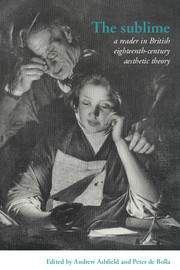Part V - Edinburgh and Glasgow
Published online by Cambridge University Press: 05 June 2012
Summary
Preoccupation with distance is a hallmark of eighteenth-century visual aesthetics, and can be found in writings on art as well as landscape. Within the analytic of the sublime distance is related to size [Hume] so that far-off objects appear to be less threatening or terrifying. Hume, however, makes the opposite case in his invocation of esteem and admiration, thereby giving a greater value to distant objects. Hume also considers temporal as well as spatial parameters and makes an important and early case for the historical imagination.
The movement from low to high [Hume] is also a pretty constant feature of the sublime tradition, unsurprisingly given the tendency to think of mountains when contemplating the sublime. Similarly the elevation of the soul is associated with the gradual ascent from the human towards the divine and furnishes the discursive analytic with another well-worn figuration. It is for this reason that, by association, virtue, riches and power [Hume] become cyphers for the sublime. This will present problems at both the ethical and political levels since some forms of power and wealth cannot be ethically sanctioned within the mainstream of civic humanism. The Scottish enlightenment attempts to square this circle, most obviously in the work of Smith, but the moral goodness of wealth and power nevertheless remain problematic.
In this movement from low to high it sometimes happens that difficulty is encountered [Hume]; given this the concept of difficulty itself comes under scrutiny and is gradually associated in and of itself with the sublime effect.
- Type
- Chapter
- Information
- The SublimeA Reader in British Eighteenth-Century Aesthetic Theory, pp. 195 - 198Publisher: Cambridge University PressPrint publication year: 1996

